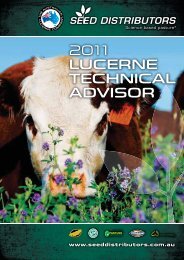Lentil variety sowing guide 2012 - Seed Distributors
Lentil variety sowing guide 2012 - Seed Distributors
Lentil variety sowing guide 2012 - Seed Distributors
You also want an ePaper? Increase the reach of your titles
YUMPU automatically turns print PDFs into web optimized ePapers that Google loves.
Lupin <strong>variety</strong> <strong>sowing</strong> <strong>guide</strong> <strong>2012</strong><br />
By Andrew Ware, SARDI, Port Lincoln,<br />
and Wayne Hawthorne, Pulse Australia,<br />
Naracoorte<br />
Narrow-leafed lupins (Lupinus<br />
angustifolius) are well suited<br />
to acid and sandy soils, and<br />
continue to be grown in suitable areas as<br />
a key component of the farming system.<br />
A good season in the eastern states in<br />
2010 has reduced domestic demand for<br />
SA lupins.<br />
Further to this, an anticipated good<br />
Western Australian crop in 2011 will also<br />
reduce the demand for lupins into the<br />
export market. This is expected to result<br />
in a significant carry-over of lupin stock<br />
from the 2010 harvest within both the<br />
South Australian storage and handling<br />
system and in on farm storage.<br />
For producers wanting to sell into<br />
Victorian and NSW markets they must<br />
satisfy anthracnose freedom, market<br />
access and transporting protocols. The<br />
rules have not changed for some years<br />
now.<br />
Anthracnose grain tests are the<br />
most common means of identifying<br />
anthracnose freedom for marketing.<br />
Paddock inspection for anthracnose<br />
freedom is usually the cheaper option<br />
per tonne of grain produced, but<br />
unfortunately this option is still not<br />
available to Eyre Peninsula lupin growers.<br />
To establish eligibility for paddock<br />
inspection, <strong>sowing</strong> seed needs to have<br />
been tested for anthracnose. This is also<br />
a sound disease management strategy<br />
elsewhere.<br />
<strong>Seed</strong> quality and emergence issues<br />
Wet conditions during the 2010 harvest<br />
meant that much of the lupin grain<br />
retained to be used as seed 2011 suffered<br />
with extremely poor germination and<br />
vigour.<br />
This was particularly prevalent with<br />
Mandelup, resulting in significant areas<br />
having to be resown. Germination and<br />
vigour tests can prove invaluable in<br />
helping to identify potential<br />
problems.<br />
Germination and seed size<br />
tests will allow growers to adjust<br />
<strong>sowing</strong> rates for a target plant<br />
density of 45 to 60 plants per m 2 .<br />
Grazing of lupin stubbles<br />
Lupin stubbles can provide<br />
a high value feed source<br />
to livestock, however in recent years a<br />
number of growers have lost significant<br />
stock numbers to lupinosis.<br />
This livestock health problem occurs as<br />
a result of toxins being produced from<br />
the phomopsis fungus that develops in<br />
the lupin stem as the plant matures.<br />
All current varieties have a reasonable<br />
level of resistance that slows the<br />
development of the phomopsis fungus.<br />
However, when significant rain occurs<br />
while the crop matures and afterwards,<br />
fungal development can still occur.<br />
Care must be taken in grazing lupin<br />
stubbles and it may advisable not to graze<br />
some paddocks at all given wet conditions<br />
at and after harvest.<br />
Lupin paddocks should be grazed at the<br />
first opportunity after harvest. Stock must<br />
have access to a good quality water supply.<br />
Older stock are less affected than young<br />
stock.<br />
Bulky crops and crop topping both aid<br />
the development of the fungus and can<br />
increase risk of lupinosis occurring.<br />
Tight lupin rotations also increase the<br />
risk.<br />
Herbicide issues<br />
Table 1. Narrow-leafed lupin <strong>variety</strong> <strong>sowing</strong> <strong>guide</strong><br />
<strong>2012</strong>.<br />
Rainfall zone (average annual rainfall)<br />
Low Medium High<br />
< 375 mm 375-500 mm > 500 mm<br />
MandelupA Mandelup A JenabillupA JenabillupA JenabillupA MandelupA WongaA Jindalee A JindaleeA Andrew Ware<br />
A combination of metribuzin<br />
and diflufenican post-emergence<br />
herbicides is registered in WA<br />
only, for use on specific varieties.<br />
This provides growers with<br />
useful options to control wild<br />
radish and other post-emergent<br />
weeds in lupin crops. In SA,<br />
metribuzin is not registered for<br />
either pre- or post-emergent<br />
application. Trial work in being<br />
conducted to obtain data to help any<br />
permit applications to APVMA for its<br />
potential use in SA.<br />
Current varieties vary in there tolerance<br />
to metribuzin with Mandelup listed in<br />
WA as being more tolerant, as are the<br />
next potential <strong>variety</strong> releases. Jenabillup,<br />
Wonga, Jindalee and Moonah are<br />
generally not rated as tolerant of post<br />
emergent metribuzin.<br />
Variety performance<br />
The longer growing season in 2010<br />
favoured Jenabillup and as such was<br />
the highest yielding <strong>variety</strong> in breeding<br />
and NVT trials across South Australia in<br />
2010, eclipsing Mandelup yields by 7%.<br />
Jenabillup has an extended flowering<br />
period that was able to capitalise on the<br />
longer growing season in 2010.<br />
The growing season in 2010 was<br />
thought to be ideal for late flowering<br />
<strong>variety</strong> Jindalee, but harvest results<br />
proved otherwise.<br />
Jindalee averaged only 81% of the<br />
site mean across all SA sites and was<br />
consistently was the poorest performer of<br />
all lines evaluated.<br />
Notes on narrow-leafed lupin<br />
varieties<br />
New Variety<br />
PBA Gunyidi A<br />
PBA Gunyidi (tested as WALAN2289)<br />
was released in WA in September 2011.<br />
<strong>Seed</strong> is available to Western Australian<br />
growers in <strong>2012</strong> and to eastern states<br />
31




